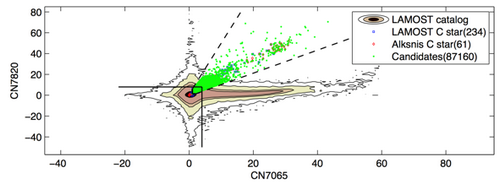Carbon stars are a kind of peculiar giant or dwarf stars with strong molecular carbon bands in their optical spectra. Recently, Ji Wei,joint graduate student of Hebei Normal University and National Astronomical Observatories of CAS, Cui Wenyuan, Professor of Hebei Normal University, and Liu Chao, Associate Professor of National Astronomical Observatories of CAS, develop a novel approach to characterize carbon stars in aspectral line indices space. In addition to the infrared photometric criteria, they are able to identify 894 carbon stars from the LAMOST DR2 database. This work has been accepted for publication in the International Journal of astronomy "Astrophysical Journal Supplement Series".
Compared to normal stars, carbon stars show an inversion of the C/O ratio (C/O > 1). Firstly, with the formation of CO, all of the oxygen was consumed in the stellar atmosphere. Then the left free carbon atoms will combine with other atoms to form CH, CN and C2, which make carbon stars look red. As the carbon giants are very luminous and easily identified by their strong band heads in their spectra, they are usually used as probes to study the kinematics and evolution of the Galaxy and external galaxies at large distance. Carbon stars are usually divided into five sub-types: C-H, C-R, C-J, C-N and C-Hd, and recently a new G-type carbon stars are also defined. So far, the origins of the C-R, C-J and G-type carbon stars are still not clear.
This team found that the known carbon stars are mostly isolated within a small branch in the space spanned by the spectral line indices of CN at around 7820A and 7065A. Based on this feature, 97% of the contaminated stars can be removed from the sample of nearly 4 million stars. Then, with an additional infrared color criteria, they further remove more contaminators with higher effective temperatures from the about 80 thousand carbon star candidates, and obtain about 6000 carbon star candidates. They finally identify 894 carbon stars by visual inspection. This is one of the largest carbon star catalogs with high purity and good consistency identified from spectroscopic surveys. In future, the C-N stars can be used to study the Galactic rotation curves since they are relatively young asymptotic giant branch stars in the Galactic disk; C-H stars can be used to study the structure and formation mechanism of the halo; C-R stars need further investigation with high resolution to clarify their formation mechanism. In addition, there are 105 suspect carbon stars in the catalog with both clear carbon and oxygen features in their spectra, which cannot be explained by the known theories. More studies on this kind of object may improve the theory of stars in future.

Distribution of line index space for carbon star candidates













